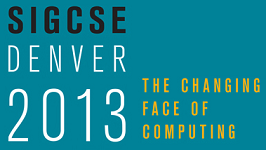Harding's fifth president, Dr. Bruce McLarty, took the reins from Dr. David Burks on June 1, 2013. He's been in office now for almost four months, and so far I believe he's done a fantastic job. Because Harding so rarely changes presidents, I thought it would be helpful to briefly summarize some of the more notable events in the transition from Burks to McLarty.
The picture below shows Dr. Burks handing over the office key to Dr. McLarty on the last day of Burks' presidency. I grabbed this pic from Dr. McLarty's Twitter feed. Yes, our new president is an avid tweeter.
For those of you reading this blog who don't know much about Dr. McLarty, he is a Harding graduate who was once a missionary in Africa and a preacher at the College Church of Christ which is located near Harding University. Eight years ago Dr. McLarty moved into academia, filling the role of vice president for spiritual life and later dean of the College of Bible and Ministry. He was named Dr. Burks' successor in November of last year. Dr. McLarty discusses the process of becoming president, his legacy and more in this online interview.
One of Dr. McLarty's first acts was to make some modest changes to the presidential cabinet. Dr. Jim Carr moved from executive VP to senior VP, and Dr. David Collins moved up to executive VP. Dr. Dan Williams was hired to fill Dr. McLarty's position as vice president for church relations, Floyd Daniel was retiring soon, and the other cabinet members were to continue with their current roles. Overall, it was a seamless continuation from the previous administration.
Summer graduation was probably Dr. McLarty's first large-scale ceremony to preside over, and he did something that many of the faculty had been secretly longing for for years: He nixed the singing of "Climb Every Mountain". Yes, the song that has traditionally been sung at the conclusion of every graduation ceremony since I can remember was finally put in its resting place.
On the first day of chapel, Dr. McLarty established a good rapport with the students by asking them what they did during the summer and using some well-placed humor, like asking Dr. Burks to spell camaraderie.
Dr. McLarty focused the first week of chapel on why Harding was unlike most universities, requiring the entire student body to attend daily chapel: "Chapel is about worship, community building, and confession." I noticed that many of the students "got it" and have put away their phones and books this semester to focus on God during chapel.
The first day of chapel Dr. McLarty also made the student body swear that if any of them ever thought they wanted to leave Harding, they'd first stop by his office and talk with him about it. Something tells me our retention levels are going to start increasing if the students will actually take him up on his offer.
We're six weeks into the fall semester, and so far it is business as usual. I imagine Dr. McLarty is still getting up-to-speed on being president, but so far the transition has been quite seamless.
I'll close with the Presidential Inauguration ceremony which occurred last Friday, Sept 20. Afternoon classes were cancelled so everyone could attend the ceremony on what was, unfortunately, a very rainy day. There were hundreds of guests on campus for the event. Some of them were representatives from other universities, like John deSteiguer, President of Oklahoma Christian University, who I chatted with briefly. The faculty were all part of the ceremony, and some served as delegates from their alma maters (I represented Old Dominion University).
You can watch the 2.5 hour ceremony online. My favorite part is the singing of The Battle Hymn of the Republic by the Harding chorus, choir, and orchestra. Look for it at minute 42 and stick around until the finale which was quite powerful.
I took the photo below which shows the former presidents Dr. Burks and Dr. Ganus placing the presidential medallion over Dr. McLary's head.
After the ceremony, the entire crowd moved to the Harding cafeteria for hors devours. It was a time of celebration as we welcomed our new president.





















